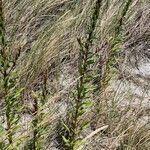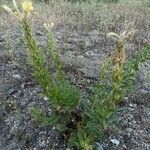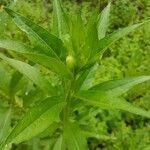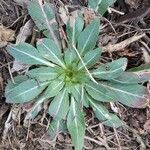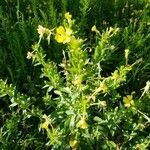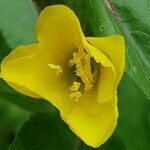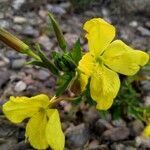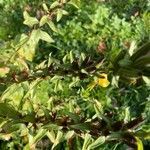Herbs erect, biennial, with taproot and basal rosette. Stems 30-150 cm tall, simple or sparsely branched, sparsely strigillose (sometimes only lower parts) mixed with glandular and long spreading pustulate-based hairs. Leaves bright green, with white or red veins, strigillose to subglabrous, sessile to shortly petiolate; rosette blade 10-30 x 1-4 cm; cauline blade lanceolate to narrowly elliptic or narrowly oblanceolate, 4-18 x 1-3 cm, base attenuate, margin dentate, apex acute. Inflorescence a dense simple or sparsely branched spike, apex often nodding or curved. Flowers open near sunset; floral tube 2.2-4 cm. Sepals 7-17 mm, with free tips 0.5-5 mm, ± subapical. Petals yellow to pale yellow, fading to orange or dull yellow, 8-15(-20) mm. Anthers 3.5-6 mm; pollen ca. 50% fertile. Ovary strigillose, with some spreading, pustulate-based, and/or glandular hairs; stigma surrounded by anthers. Capsules dark green, drying nearly black, narrowly lanceoloid to lanceoloid, 2-4 cm, sessile. Seeds in two rows per locule, brown to dark brown, 1.1-1.8 mm, irregularly pitted.
Resembling no. 3 and often mistaken for it; infl-tips nodding; hypanthium 1.5–4 cm; sep 1–2 cm, the free tips 1–3 mm, subterminal, the actual end of the sep represented by a distinct transverse ridge or a small lobe; pet 1–2 cm; anthers 4–7 mm; style 0.5–2.5 cm; fr 1.5–4 cm, only slightly tapering; seeds 1.8–2.2 mm; 2n=14, a complex heterozygote. Disturbed open places, abundant especially northward; Nf. to Va. and W.Va., w. to Minn. and Ark. July–Oct. Highly variable. Closely and minutely canescent-strigulose plants, without gland-tipped hairs, occur mainly from Mass. to Va. and have been called var. oakesiana (Robbins) Fernald (O. oakesiana), in contrast to var. parviflora, widespread but more common northward, with intermingled long and short hairs, often some of them gland-tipped, varying to nearly glabrous. (O. angustissima; O. cruciata)
